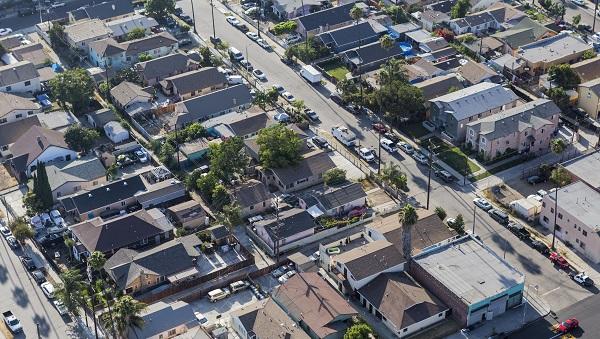Poorer Neighborhoods Pose Risks for Black Patients After Acute MI
The same social determinants of health that increase MI risk are there to greet patients when they return home, one expert notes.

The combination of living in a disadvantaged neighborhood and being Black significantly raises the risk of death in the years after being discharged for an acute MI, new research shows.
“It makes sense,” Quinn Capers IV, MD (University of Texas Southwestern Medical Center, Dallas), chair of the ACC’s diversity and inclusion committee, commented to TCTMD. The study adds evidence, he said, to support the idea that the same social determinants of health that increase risks for having an MI—things like crowded living spaces, pollution, and impaired access to quality food and exercise—are likely to negatively impact post-MI patients after discharge, as well.
“They're going back to that same neighborhood where maybe there's not a safe place to go for a walk. Maybe they're living in a food desert where it's not easy to get fresh fruits and vegetables, but on every corner there's a fast food restaurant, and there's also a lot of car exhaust,” Capers said. “Those kind of social determinants of health have a profound impact.”
The study was released early ahead of its scheduled presentation at the virtual American College of Cardiology 2021 Scientific Session.
Barriers and Contributors to Outcomes
For the analysis, Goitia and colleagues examined data on 31,747 patients admitted for an acute MI within the Kaiser Permanente Southern California hospital system between 2006 and 2016. Each patient was assigned a neighborhood disadvantage score using the Area Deprivation Index. The index is a 17-item metric that uses such variables as education, income, employment, and household characteristics. Neighborhoods of patients in the study who were considered well-resourced ranked in the first through 25th percentile, while those considered disadvantaged ranked between the 26th and 100th percentile.
At 5.2 years of follow-up, living in a disadvantaged neighborhood versus a well-resourced neighborhood was an independent predictor of all-cause mortality after MI (HR 1.05; 95% CI 1.01-1.08), even after adjustment for age, sex, race/ethnicity, comorbidities, and medications. However, for Black patients from disadvantaged neighborhoods, the risk of all-cause mortality was higher than for either white patients from well-resourced neighborhoods (HR 1.19; 95% CI 1.11-1.28) and white patients from disadvantaged neighborhoods (HR 1.14; 95% CI 1.06-1.23). No mortality association was seen for Black patients from well-resourced areas compared with white patients.
Goitia agreed that social determinants of health have a substantial impact on both the index hospitalization and the poor outcomes post-MI. “Additionally, the increased stress of living in a disadvantaged neighborhood is likely another contributor to these worse outcomes that we are seeing,” he added.
We need to work toward getting everyone some type of cardiac rehab, whether their socioeconomic status allows them to go to a hospital program or not. Quinn Capers IV
As Capers pointed out to TCTMD, previous studies have shown that Black patients are less likely to be prescribed cardiac rehabilitation after MI than white patients, and even when it is prescribed, they're less likely to be able to go.
“They may have a job where they tell their boss that for the next 6 weeks, every Monday, Wednesday, and Friday I have to leave work early and go to this rehab program. And the boss tells them no, or it’s just impossible for them to get there,” Capers noted. “So, one thing that we can do is to try to make that more accessible. Maybe we need to be more creative about educating people about what they could do at home if they can't take off time to go to rehab, because it's really about being sure that you get your heart rate up 30 minutes a day, and it's about the nutritional advice we want them to remember. We need to work toward getting everyone some type of cardiac rehab, whether their socioeconomic status allows them to go to a hospital program or not.”
Another barrier to adequate recovery is not taking prescribed medications and/or having problems accessing community pharmacies. In-patient pharmacy programs such as “meds-to-beds” can help, Capers said, by ensuring that patients have all their meds before they are discharged.
“Telemedicine visits where you don't even have to have a fancy computer, but just be on your phone and your doctor can check in with you, is another option,” he said. “It’s a way that someone can just step away from the job for a 15-minute conversation with either their doctor or their nurse or [other] provider.”
Although the study endpoint was all-cause mortality, Goitia said looking more closely at the causes of death, particularly cardiac-related reasons, may shed more light on the differences between the populations and their risk profiles.
“In this study, unfortunately, we were not able to identify any particular cause, but it is hypothesis generating and definitely something that we would like to investigate further to see what specific metrics that were used in this index could be driving the overall worse mortality that we saw,” he concluded.
L.A. McKeown is a Senior Medical Journalist for TCTMD, the Section Editor of CV Team Forum, and Senior Medical…
Read Full BioSources
Goitia J. Racial differences in the effects of neighborhood disadvantage on long-term survival after acute myocardial infarction. Presented at: ACC 2021. May 17, 2021.
Disclosures
- Goitia and Capers report no relevant conflicts of interest.





Comments